Delve into the precision-driven world of the investment casting process. A comprehensive resource that unravels the complexities and nuances of a key manufacturing technique. At the heart of industries ranging from aerospace to medical technology, and virtually every industry requiring metal components, investment casting is celebrated for its ability to produce intricately detailed, high-quality components.
Through this guide, crafted by the seasoned professionals at Niagara Investment Castings, you will journey through the meticulous steps of the investment casting process. We aim to equip you with a thorough understanding of how this time-honored technique seamlessly integrates with modern technological advancements, highlighting its applications and the significant advantages it brings to contemporary manufacturing.
What is the Investment Casting Process?
Investment casting is a sophisticated metal forming process renowned for its precision and the ability to produce complex, high-quality components. The method typically begins with creating a wax pattern encased in a ceramic shell to form a detailed mold. Once the ceramic shell is dry, the wax is melted away, leaving a cavity in the shape of the desired part. Molten metal is poured into this mold and solidified, and the final casting is revealed after the ceramic is removed.
Applications Across Industries
The process is crucial in industries where precision and complexity are paramount. Notably, it’s used in a wide range of both commercial and critical applications where investment casting will provide the unique combination of value and fit-form-function.
Advantages of Investment Casting
This method is particularly suited for geometrically complex parts requiring fine details and thin sections and high precision and quality. It allows for creating parts with intricate geometries that might be challenging or impossible to achieve with other methods.
Surface and Dimensional Accuracy
Investment casting is known for producing parts with exceptional surface finishes and high dimensional accuracy. This precision is especially beneficial for components that require minimal post-casting processing.
Technological Integration
Modern advancements, such as using 3D printing technology for creating disposable wax or plastic patterns, have further enhanced the efficiency and capabilities of investment casting. This integration of technology allows for more flexibility in design and rapid prototyping.
Investment casting stands out for its ability to produce detailed, high-quality components, making it a key process in precision manufacturing across diverse sectors.
Materials Used in the Investment Casting Process
The investment casting process is renowned for its flexibility in working with a wide range of metals and alloys, each chosen for specific properties to meet the demands of various applications. Commonly used materials include:
Carbon Steel
Carbon steel investment castings are often selected for their balance of strength, flexibility, and cost-effectiveness. They are extensively used across industries for parts that require limited post-casting work and offer high dimensional accuracy and repeatability.
- Automotive components: Gears, valves, and engine parts due to their need for strength and durability.
- Industrial machinery parts: High-strength components in heavy machinery for their robustness and wear resistance.
Stainless Steel Alloys
Stainless steel is used for its corrosion resistance and strength. Various stainless steel alloys have different casting characteristics and require careful process control to achieve good results.
- Pump and Valve Components: Impellers, seals, bodies, and valve components make up the largest tonnage of stainless steels cast due to the alloys corrosion resistance, strength, and ease of castability.
- Medical devices: Surgical tools and implants, chosen for their corrosion resistance and biocompatibility.
- Food processing equipment: Various parts that require hygiene and resistance to corrosion and heat.
Brass and Other Non-Ferrous Metals
Brass is popular for functional and decorative investment castings due to its versatility, attractive appearance, and corrosion resistance. Investment casting also accommodates other non-ferrous metals like bronze and copper, offering diverse options for manufacturers.
- Decorative items: Sculptures and ornaments, appreciated for their aesthetic appeal and fine detailing.
- Heat Transfer Superiority: Components where thermal transfer properties are paramount over strength or corrosion resistance.
These materials are selected based on the application’s specific requirements, such as strength, corrosion resistance, weight, and thermal properties. The choice of material significantly influences the casting process, impacting factors like mold design, melting temperatures, and post-casting treatments.
Step-by-Step Guide to the Investment Casting Process
1. Wax Pattern Formation
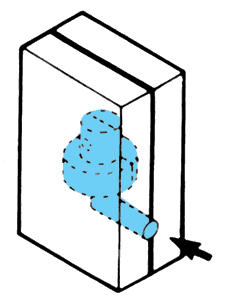
A wax pattern is produced by injecting melted wax under high pressure into an aluminum injection die. This die is pre-engineered by Niagara Investment Castings to allow for proper wax introduction on our presses. The die may be a single cavity, or multiple cavities, depending on the typical number of castings run per order. The die also may have a series of “pulls” which are used to form internal geometries, or may use soluble or ceramic cores for more complex internal detail. The die is also built with a shrinkage allowance on the geometry, so that the wax produced is LARGER than the finished casting, since both the wax pattern and the casting itself will SHRINK during the transition of both to solid from liquid.
Wax patterns can also be produced by “printing” the pattern in any number of materials available using our 3D stereo lithography technology, allowing for investment castings to be produced without the need for the injection tool, however this would only generally be considered for samples, research and development, or one time small runs of product.
2. Wax Pattern Removal
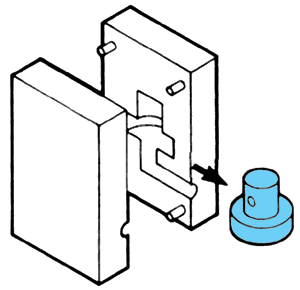
The wax pattern, which is an exact replica of the required part, is removed from the die, either manually or with built-in ejectors. Many times the gating system, pre-engineered and tested during the sampling stage, is cut into the die so that the gates are always on the pattern, for consistency of metal feeding of the casting.
3. Precision and Planning
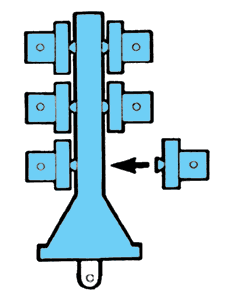
The wax patterns are attached to a central wax bar, called a sprue, to form a cluster or tree. This tree provides the pre-engineered feed metal gating requirements are able to be met, while at the same time providing the support needed to hold the wax patterns in place throughout the shelling process. Niagara Investment Castings has several pre-engineered sprues, including multi leg, and bottom pour sprues for enhanced casting quality of difficult to pour alloys. The sprue has a ceramic pouring cup already attached to the top to provide a solid, clean metal pouring port for the casting operation to come, as well as a metal support rod embedded in the wax sprue to allow our robots to grip onto the wax tree to perform the shelling operations.
4. Initiating the Ceramic Shell
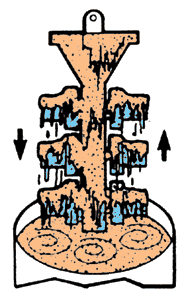
Using our multi-axis robot, the tree is dipped into one of a series of ceramic slurries. Each slurry is made from a water based colloidal silica, with various types and consistencies of ceramic powders added to form the high grade ceramic. The dipping of the wax tree into the slurry is also called investing the tree, and is where the term “investment casting” originated. This is intended to differentiate this precision casting process from “solid mold” precision ceramic mold casting, which also uses ceramic slurry, but rather than building a thin shell, the wax pattern is encased in a solid mass of ceramic. Dental appliance manufacturers and jewellery manufacturers use solid mold casting, where industrial precision casting uses shell molding almost exclusively due to its ability to be more geared to production at lower costs.
5. Layering the Ceramic Shell
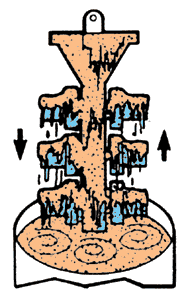
After each layer of liquid slurry is added, coatings of progressively coarser refractories is added to the still wet slurry using either a rainfall sander, or fluidized beds for the later coats, to give the shell strength and add thickness to it. This continues until a self supporting shell or mold is formed.
6. Completing the Shell Mold
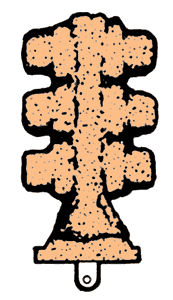
A self supporting shell or mold is finished when approximately 3/8″ to 1/2″ thick.
7. The De-Waxing Furnace
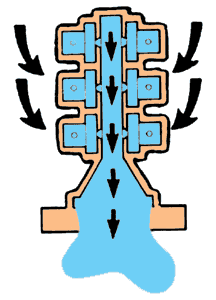
Once the mold is dry, it is inverted, and heated in our state-of-the-art flash fire de-waxing furnace or our steam autoclave to allow the wax to run out of the shell, where it is collected and recycled for use as the sprue wax.
8. The Sintering Process
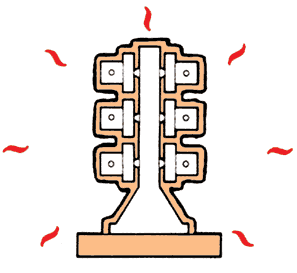
The tree is fired at a high temperature to sinter the ceramics which make up the mold to give it significant strength, and this process also preheats the mold for pouring, so that the thermal shock of the molten metal entering the shell on the subsequent pouring operation will not break the thin ceramic wall.
9. The Metal Pouring
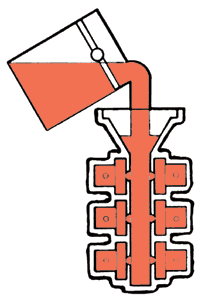
Metal is prepared for pouring by alloying in our specialized induction furnaces, melting to the suitable tap out temperature, tested for conformance to the metallurgy required, and when all quality assurance approvals are given, the molten metal is poured into the heated shell mold, through a filter in the top pour cup to ensure optimum casting integrity and soundness. Once filled, the molds are allowed to cool and the molten metal alloy solidify as it turns into the casting.
10. Mold Removal Techniques
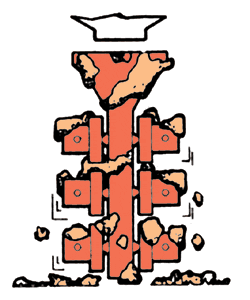
After cooling, the mold material is removed by vibration, chemical cleaning, waterjet blasting, or mechanical blasting.
11. Cutting, Cleaning, and Shipping
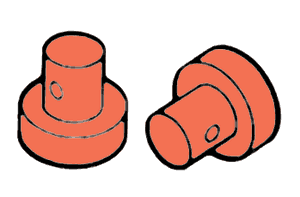
Parts are cut out from the sprue using one of several cut-off techniques we employ, through the gate that was holding the casting to the sprue. The gates are lightly ground, and the castings proceed to final surface treatments such as shot blasting, sand or oxide blasting, or other treatments. In cases where heat number traceability is required, we etch the serialized numbers onto each casting. Following any applicable heat treatment, NDT testing, machining, or other certification testing required, the castings are 100% inspected and prepared for shipment to our customers.
History and Evolution of Investment Casting
Ancient Times (over 5,000 years ago)
Investment casting originated with ancient civilizations worldwide, including Mexico, Mesopotamia, and Egypt. The process primarily involved beeswax, which was used to create detailed artwork and jewelry.
Late 19th Century
The modern adaptation of investment casting began. It saw increased use in dental applications for crowns and inlays, marking the transition of the process into more industrial applications.
1940s
A significant surge in investment casting occurred, driven by the demand for precision net shape manufacturing during World War II. This period marked the evolution of the process for specialized industrial components beyond its traditional use in art and jewelry.
Early 20th Century
The development of stainless steel further revolutionized investment casting. Stainless steel’s properties, such as strength, corrosion resistance, and heat tolerance, opened new avenues for industrial applications.
Present Day
Investment casting has become a critical process in various industries, facilitated by technological advancements like 3D printing for rapid prototyping. This evolution has enabled more efficient, cost-effective production and broadened the range of possible applications.
Frequently Asked Questions About the Investment Casting Process
How long does it take?
The time for investment casting can vary significantly based on the complexity and size of the part, but typically, it takes between 4 to 6 weeks from the creation of the wax pattern to the final casting.
Is investment casting expensive?
Investment casting is generally more costly than other casting methods due to its intricate process and equipment, but it’s cost-effective for producing more complex and detailed parts due to the ability to cast to “near net shape and size” versus those other casting processes.
What is an example of investment casting?
Some common examples of investment casting are the production of pump and valve parts, components used in marine applications, military weapons, mining and forestry machinery, and turbine blades used in aerospace engines.
How accurate is investment casting?
Investment casting is highly accurate, producing parts with tight tolerances of plus/minus 0.005″ per inch and excellent surface finishes.
What equipment is used in investment casting?
Key equipment includes wax pattern molds, ceramic slurry containers, furnaces for melting wax and metal, and tools for finishing and inspecting the final product.
Why is it called investment casting?
“Investment” refers to coating a wax pattern with refractory material to create a mold, a crucial step in casting.
What is the purpose of investment casting?
Investment casting primarily aims to create precise, complex metal components with exceptional dimensional accuracy and surface finish.
The Enduring Significance of Investment Casting
The investment casting process stands as a testament to the incredible capabilities of modern manufacturing. With its roots extending back to ancient times and evolving through the centuries, this process now integrates cutting-edge technology and materials to produce exceptional quality and complex components. No matter what the geometry is, or how critical the final application is, investment casting delivers with precision and efficiency.
At Niagara Investment Castings, we pride ourselves on being at the forefront of this technology, providing our clients with high-quality investment cast products and services. Our commitment to excellence and innovation ensures that we remain a leader in the industry. For more information on how our expertise in investment casting can benefit your project, visit Niagara Investment Castings.
